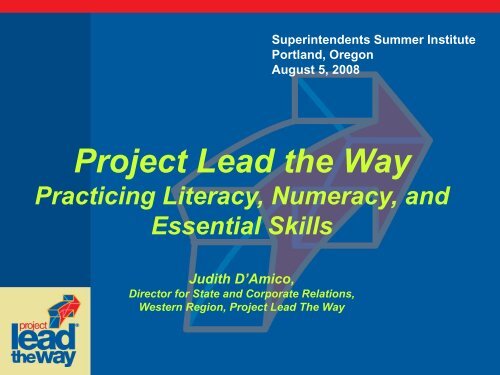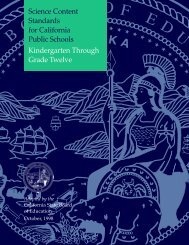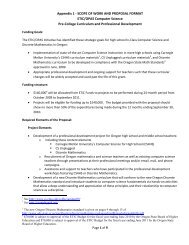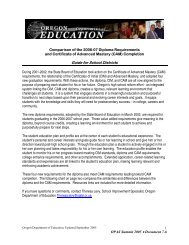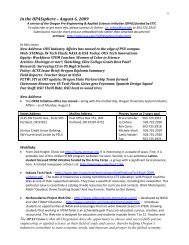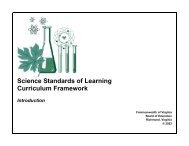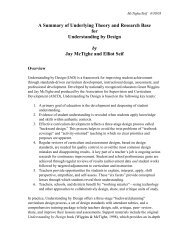Project Lead the Way (PLTW) - OPAS
Project Lead the Way (PLTW) - OPAS
Project Lead the Way (PLTW) - OPAS
Create successful ePaper yourself
Turn your PDF publications into a flip-book with our unique Google optimized e-Paper software.
Superintendents Summer Institute<br />
Portland, Oregon<br />
August 5, 2008<br />
<strong>Project</strong> <strong>Lead</strong> <strong>the</strong> <strong>Way</strong><br />
Practicing Literacy, Numeracy, and<br />
Essential Skills<br />
Judith D’Amico,<br />
Director for State and Corporate Relations,<br />
Western Region, <strong>Project</strong> <strong>Lead</strong> The <strong>Way</strong>
<strong>Project</strong> <strong>Lead</strong> The <strong>Way</strong><br />
<strong>PLTW</strong> is a not-for-profit organization.<br />
<strong>PLTW</strong> formally partners with public<br />
schools, higher education institutions and<br />
<strong>the</strong> private sector to grow <strong>the</strong> science,<br />
engineering and technology workforce.<br />
Fall of 2008, <strong>PLTW</strong> is in over 3,000 schools<br />
in 50 States and <strong>the</strong> District of Columbia.<br />
2
The US needs 400,000 engineering, science,<br />
math and technology graduates annually, and<br />
we are currently producing 225,000.<br />
According to “Tapping America’s Potential” report<br />
from <strong>the</strong> National Business Roundtable<br />
<strong>Project</strong> <strong>Lead</strong> The <strong>Way</strong> is committed<br />
to <strong>the</strong> goal of 10,000 schools and<br />
1,000,000 students by 2012
Belief in “Education for All”<br />
Understanding engineering is essential for all citizens,<br />
workers, and consumers in a modern democracy<br />
Public support of engineering is necessary if <strong>the</strong> U.S. is<br />
to continue to play a significant role in <strong>the</strong> world<br />
economy<br />
Technology and engineering are viable careers only if<br />
students take <strong>the</strong> appropriate courses in high school<br />
Engineering education for all is an important aspect of<br />
equity for girls and minority students<br />
The capability to formulate and solve problems is a<br />
valuable life skill<br />
Cary Sneider Vice President for Educator Programs, Museum of Science, Boston
<strong>Project</strong> <strong>Lead</strong> <strong>the</strong> <strong>Way</strong> (<strong>PLTW</strong>) provides engineering and<br />
biomedical science curriculum based on current cognitive<br />
research and national standards (NSES, ITEA, NCTE,<br />
NCTM, ASEE).<br />
<strong>PLTW</strong> provides a structure and venue for students to:<br />
• practice reading for meaning;<br />
• apply math;<br />
• test <strong>the</strong>ir understanding by physical and virtual application;<br />
• work with peers and technology to create, document and<br />
manage projects;<br />
• cultivate a deeper understanding of technical processes;<br />
• think critically and analytically to solve problems; and<br />
• present solutions in writing, diagrams, and speech.<br />
Learning and using essential skills
What We Know<br />
When business is asked what skills and abilities<br />
<strong>the</strong>y want education to deliver in <strong>the</strong>ir workforce,<br />
whe<strong>the</strong>r <strong>the</strong> technical or professional workforce,<br />
<strong>the</strong> answer is <strong>the</strong> same:<br />
‣ Ability to think critically<br />
‣ Ability to problem solve, both in predictable and<br />
unpredictable situations<br />
‣ Ability to collaborate effectively in doing both of<br />
<strong>the</strong> above.<br />
THE ABILITY TO INNOVATE!
The New Oregon Diploma’s Essential Skills<br />
Read a variety of text<br />
Write clearly and accurately<br />
Listen actively and speak clearly and<br />
coherently<br />
Apply math<br />
Think critically and analytically<br />
Use technology to live, learn, and work<br />
Demonstrate civic and community<br />
engagement<br />
Demonstrate global literacy<br />
Demonstrate personal management and<br />
teamwork skills
WHAT SETS <strong>PLTW</strong><br />
CURRICULA APART
MANAGED DELIVERY OF PROJECT<br />
LEAD THE WAY CURRICULUM<br />
Quality Control<br />
Rigorous & Relevant Professional<br />
Development – summer and ongoing training<br />
for teachers and counselors<br />
Industry Engagement in Curriculum<br />
Development – updated every 3 years<br />
Program evaluation – shared data among<br />
states; publications; ongoing initiatives
Curriculum based on research<br />
How People Learn<br />
by <strong>the</strong> National Research Council<br />
Understanding by Design<br />
by <strong>the</strong> Wiggins & McTighe<br />
Achieving Rigor & Relevance Through<br />
<strong>Project</strong>-Based Learning<br />
by <strong>the</strong> Daggett & Blais<br />
ABET, Inc. Accreditation Criteria<br />
National Standards
<strong>PLTW</strong> Aligns Key Learning<br />
Concepts to National Standards<br />
National Science Education Standards<br />
Principles and Standards of School<br />
Ma<strong>the</strong>matics<br />
Standards for Technological Literacy<br />
Standards for English Language Arts<br />
National Content Standards for<br />
Engineering and Engineering Technology<br />
National Health Care Cluster Foundation<br />
Standards<br />
ABET, Inc. Accreditation Criteria<br />
11
Quality Standards for Colleges of Engineering Set<br />
By Accreditation Board for Engineering and<br />
Technology (ABET)<br />
College engineering programs must<br />
demonstrate that <strong>the</strong>ir students<br />
attain specified outcomes<br />
When <strong>PLTW</strong> curriculum is<br />
implemented, <strong>the</strong> foundations for<br />
those postsecondary outcomes are<br />
integrated throughout.
<strong>PLTW</strong> Math & Science Connections<br />
IED<br />
‣ Algebra I & II<br />
‣ Cartesian coordinate<br />
system<br />
‣ Geometry<br />
CIM<br />
‣ Students apply IED concepts<br />
‣ Algebra I & II<br />
‣ Geometry<br />
‣ Trigonometry<br />
‣ Chemistry<br />
DE<br />
‣ Students need to be<br />
logical thinkers<br />
‣ Need understanding of<br />
Boolean Logic<br />
‣ Physics (electricity) &<br />
(chemistry)<br />
Specialized<br />
Courses<br />
‣ Algebra I & II<br />
‣ Geometry<br />
‣ Trigonometry<br />
POE<br />
‣ Algebra I<br />
‣ Statistics concepts<br />
‣ Physics<br />
‣ Chemistry<br />
EDD<br />
Math depends<br />
on selected<br />
project<br />
‣ Trigonometry<br />
‣ Pre-Calculus<br />
‣ Calculus concepts
<strong>PLTW</strong> Provides Resources for:<br />
.<br />
Reading Across <strong>the</strong> Curriculum: Students read, discuss, and reflect on topical writing.<br />
A selection of suggested books<br />
And Suddenly The Inventor Appeared: TRIZ, The <strong>the</strong>ory of Inventive Problem Solving By Henry Altshuller<br />
In this book <strong>the</strong> reader can work through 78 real problems that have a range of difficulty. An invention is needed<br />
in each. In <strong>the</strong> process of solving <strong>the</strong> problems <strong>the</strong> reader learns to apply 27 practical thinking tools and<br />
techniques.<br />
Success through Failure/; The Paradox of Design By Henry Petroski -- From <strong>the</strong> clumsy packaging of Aleve<br />
pain reliever to <strong>the</strong> space shuttle Columbia disaster, this engrossing study mourns and celebrates failed<br />
designs that spur fur<strong>the</strong>r improvement.<br />
Writing Across <strong>the</strong> Curriculum: Students research key terms and applications of<br />
concepts in <strong>the</strong> course as individuals or groups:<br />
If <strong>the</strong> writing activity is completed individually, <strong>the</strong>n <strong>the</strong> teacher may want to require <strong>the</strong> students to<br />
write a story about traveling in a time machine and visiting someone from <strong>the</strong> past or future. The<br />
teacher may determine <strong>the</strong> circa. Students will explain <strong>the</strong> role of <strong>the</strong> key term or concept played in <strong>the</strong><br />
lives of various people <strong>the</strong>y would encounter during <strong>the</strong>ir time travel. The students should also explain<br />
how key term or concept may have helped to or could have improved some form of technology present<br />
in <strong>the</strong> time traveled land <strong>the</strong>y visited.
<strong>PLTW</strong> Curriculum<br />
• Blueprint that is based on concepts, national<br />
standards (i.e., English, Ma<strong>the</strong>matics, Science,<br />
Technology, and ABET, Inc.), performance<br />
objectives, and essential questions<br />
• Lessons utilize activity-, project-, and problembased<br />
learning (AP 2 )
APPB LEARNING WORKS<br />
In response to <strong>the</strong> Desired Skills<br />
Identified by Business & Industry:<br />
<strong>PLTW</strong> Curriculum develops all three<br />
skills: critical thinking, problem solving,<br />
and collaborative abilities through<br />
Activities, <strong>Project</strong> and Problem-based<br />
Learning.
CREATING THE INNOVATION<br />
GENERATION<br />
ACTIVITIES<br />
LEVEL 1: COGNITIVE<br />
PROJECTS<br />
LEVEL 2: NOVICE<br />
METACOGNITION<br />
PROBLEMS<br />
LEVEL 3: EXPERT<br />
METACOGNITION<br />
Students are engaged in<br />
designing, researching,<br />
investigating, computing,<br />
and comprehending<br />
information in a directed<br />
learning environment<br />
Students begin to monitor<br />
<strong>the</strong>ir own thinking and develop<br />
strategies to solve problems<br />
in an environment that is longterm,<br />
interdisciplinary, studentcentered,<br />
and integrated with<br />
real world issues.<br />
Students understand <strong>the</strong> nature of<br />
a problem and self-assess <strong>the</strong>ir<br />
knowledge in an environment that<br />
promotes <strong>the</strong>ir investigating,<br />
designing, testing, applying, revising,<br />
and explaining and developing<br />
strategies to enable and direct<br />
<strong>the</strong>ir own learning.
Gateway to Technology<br />
Design and Modeling<br />
The Magic of Electrons<br />
The Science of Technology<br />
Automation and Robotics<br />
Flight and Space<br />
Under Development<br />
Energy and Power<br />
18
HS Engineering Program<br />
Foundation Courses:<br />
Introduction to Engineering Design<br />
Principles of Engineering<br />
Digital Electronics<br />
Specialization Courses (HS offers 1 or more):<br />
Computer Integrated Manufacturing<br />
Civil Engineering/Architecture<br />
Biotechnology<br />
Aerospace Engineering<br />
Capstone Course:<br />
Engineering Design & Development<br />
Note: Course program<br />
requires college entrance<br />
ma<strong>the</strong>matics each year.<br />
19
NEWEST <strong>PLTW</strong> PATHWAY<br />
BIOMEDICAL SCIENCES
Biomedical Sciences High<br />
School Courses<br />
Principles of <strong>the</strong> Biomedical Sciences<br />
Students study research processes, human medicine and are<br />
introduced to bio-informatics.<br />
Human Body Systems<br />
Students study basic human physiology, especially in relationship to<br />
human health.<br />
Medical Interventions<br />
Students investigate various medical interventions that extend and<br />
improve quality of life, including gene <strong>the</strong>rapy, pharmacology, surgery,<br />
pros<strong>the</strong>tics, rehabilitation, and supportive care.<br />
Science Research Capstone Course<br />
Students work with a mentor, identify a science research topic,<br />
conduct research, write a scientific paper, and defend team<br />
conclusions to a panel of outside reviewers.
WHAT RESEARCH IS<br />
TELLING US ABOUT<br />
SUCCESS OF PROJECT<br />
LEAD THE WAY
How Well is <strong>PLTW</strong> Working<br />
Research Data<br />
Key Findings based upon 450 <strong>PLTW</strong> students<br />
80% of <strong>PLTW</strong> seniors plan on attending college<br />
or community college versus 65% nationwide.<br />
54% plan to study engineering or engineering<br />
technology versus 10% nationally.<br />
19% plan on attending Community College or<br />
Technical School.<br />
85% student retention rate in 2 nd year of<br />
Engineering or Eng. Tech. versus ~60%<br />
nationwide.<br />
23
How Well is <strong>PLTW</strong> Working<br />
According to TrueOutcomes (July 2006)<br />
KEY FINDINGS<br />
Students in schools of average affluence (20-<br />
40% subsidized lunches) did as well as<br />
students in more affluent schools (less than<br />
20% subsidized lunches).<br />
College transcripts of <strong>PLTW</strong> graduates<br />
indicate <strong>the</strong> average GPA is slightly above 3.0<br />
and average grades in freshman calculus,<br />
physics, and chemistry are B or better.<br />
24
How Well is <strong>PLTW</strong> Working<br />
High Schools That Work (HSTW)<br />
Sou<strong>the</strong>rn Regional Education Board (May 2005)<br />
<strong>PLTW</strong> Students -- KEY FINDINGS<br />
Achieved significantly higher in<br />
ma<strong>the</strong>matics than students in comparable<br />
career and technical programs.<br />
Achieved significantly higher in<br />
ma<strong>the</strong>matics, science, and reading than all<br />
students in o<strong>the</strong>r CTE programs.<br />
Completed significantly more higher-level<br />
ma<strong>the</strong>matics and science courses.<br />
Included in your handouts<br />
25
<strong>Project</strong> <strong>Lead</strong> The <strong>Way</strong><br />
TrueOutcomes – New Initiative<br />
Collaborating to develop a K-20 data<br />
quality exchange model – state leaders<br />
will share data with national <strong>PLTW</strong><br />
Result will be a massive data system<br />
with incredible analytical capabilities<br />
Inclusion for all states and colleges<br />
within <strong>the</strong> <strong>Project</strong> <strong>Lead</strong> The <strong>Way</strong>®<br />
network.<br />
Most reliable way for STEM educators<br />
and researchers to identify quantitative<br />
indicators and achieve statistically<br />
significant results.
<strong>PLTW</strong> Closed <strong>the</strong> Achievement Gap at<br />
Galt Joint Union High School District<br />
At Galt High, <strong>PLTW</strong> students take one class<br />
per school year, beginning in 9 th grade:<br />
• Digital Electronics<br />
• Principles of Engineering<br />
• Civil Engineering and Architecture<br />
• Computer Integrated Manufacturing<br />
Critical Question: What impact, if any, has<br />
<strong>Project</strong> <strong>Lead</strong> <strong>the</strong> <strong>Way</strong> had in closing <strong>the</strong><br />
achievement gap for Hispanic/Latino<br />
students
Has <strong>PLTW</strong> helped close <strong>the</strong> achievement gap<br />
for Hispanic/Latino students<br />
ENGLISH LANGUAGE ARTS 2004 2005 2006<br />
White Students 348.56 357.49 357.10<br />
Hispanic Students 318.98 325.60 325.57<br />
Achievement Gap -25.58 -31.89 -31.53<br />
<strong>PLTW</strong> Hispanic Students 369.59 381.41 383.31<br />
Achievement Gap Closed Closed Closed<br />
<strong>PLTW</strong> Hispanic/Latino Students vs. Mainstream White students<br />
+ 21.03 pts. +23.92 pts. +26.21pts.
Has <strong>PLTW</strong> helped close <strong>the</strong> achievement gap for<br />
Hispanic/Latino students<br />
MATHEMATICS 2004 2005 2006<br />
White Students 313.89 320.37 322.49<br />
Hispanic Students 301.05 308.10 309.05<br />
Achievement Gap -12.84 -12.27 -13.44<br />
<strong>PLTW</strong> Hispanic Students 327.35 347.42 351.62<br />
Achievement Gap Closed Closed Closed<br />
<strong>PLTW</strong> Hispanic Students compared to Mainstream White Students<br />
+13.46 pts. +27.05 pts. +29.13 pts.
Has <strong>PLTW</strong> helped close <strong>the</strong> achievement gap<br />
for Hispanic/Latino students<br />
SCIENCE 2004 2005 2006<br />
White Students 326.18 336.42 335.45<br />
Hispanic Students 305.05 313.96 315.43<br />
Achievement Gap -21.13 -22.46 -20.02<br />
<strong>PLTW</strong> Hispanic Students 340.53 356.43 362.50<br />
Achievement Gap Closed Closed Close<br />
<strong>PLTW</strong> Hispanic Students compared to Mainstream White Students:<br />
+14.35 pts. +20.01 pts. +27.05 pts.
How has <strong>PLTW</strong> helped close <strong>the</strong> achievement<br />
gap for Hispanic/Latino students<br />
Results:<br />
For three consecutive years, <strong>PLTW</strong> students<br />
scored higher than o<strong>the</strong>r students at Galt H.S. in<br />
all 5 subjects on <strong>the</strong> 2006 California Standards<br />
Tests (CST): English Language Arts, Ma<strong>the</strong>matics,<br />
Science, History/Social Science, and Life Science.<br />
For three consecutive years, Hispanic/Latino<br />
<strong>PLTW</strong> students scored higher than o<strong>the</strong>r<br />
Hispanic/Latino students at Galt H.S. and higher<br />
than <strong>the</strong> average overall student scores in all 5<br />
CST subject areas.
FROM INTEL CORPORATION<br />
"<strong>PLTW</strong> is preparing students today to be <strong>the</strong><br />
innovators of <strong>the</strong> future. For California to remain<br />
<strong>the</strong> innovation leader it is critical for our students<br />
to enter into <strong>the</strong> workforce pipeline that have not<br />
only math, science and engineering skills, but<br />
are also able to solve problems, work as a team<br />
and take risks. <strong>PLTW</strong> is a program that gives<br />
<strong>the</strong> students <strong>the</strong> tools <strong>the</strong>y need to compete in<br />
<strong>the</strong> global marketplace.“<br />
Michael Jacobsen, California/Texas<br />
Public Affairs Manager, Intel
Visit <strong>the</strong>se Websites for more<br />
Information<br />
WWW.<strong>PLTW</strong>.ORG<br />
For more Oregon-specific information:<br />
http://opas.ous.edu///<strong>PLTW</strong>_Advocacy/index.html<br />
Judith D’Amico, Director<br />
State and Corporate Relations<br />
judithdamico@comcast.net


